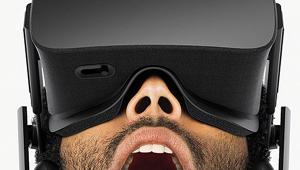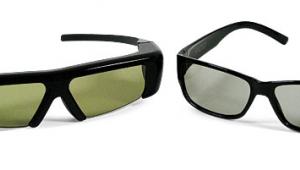3D...Now?
For 50-some years, 3D has been promised as the next big thing in entertainment. In reality, it has been around a lot longer than that. Everyone remembers (or at least has seen references to) the red-and-blue or polarized glasses of yore that let you experience the likes of Captain EO and Jaws 3D in all their "glory." Some heavyweights in the movie industry are really pushing for 3D again, and its success in theaters may or may not have any effect on whether you bring 3D into your home. Personally, I feel my life is 3D enough and would prefer more 2-D, but that's just me.
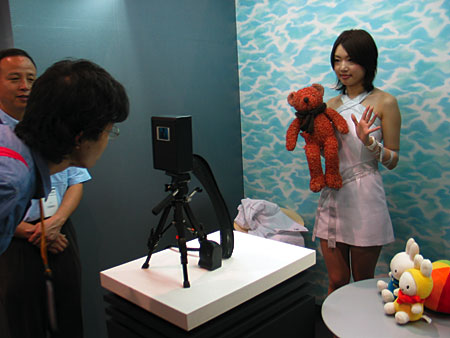
For any 3D format to take off, I believe you can't do it with glasses. It's a hassle that may or may not work in the theater, but I don't see much success at home in store for it. Some sort of magic has to happen for us to see 3D—you know, as in more than we do naturally.
In our November 2003 issue, editor-at-large Darryl Wilkinson reviewed the Sensio 3D processor. It's a fascinating product that creates convincing 3D, but it requires fancy glasses with shutters. What did I just say? No glasses! This was fine four years ago, but time moves.
So, how do you make this magic work? After all, wasn't making TVs flat the culmination of the past 50 years of TV development? Well, it turns out that making TVs flat was a step in the right direction for 3D home displays, too. In the April 2006 issue, I talked about Sharp's Two-Way Viewing-Angle LCD, which could potentially be adapted to create 3D without glasses. Now we're talking. Think of it as a thin picket fence in front of a regular LCD. This fence directs light from certain pixels toward your right eye and light from the other pixels to your left. If the processing is correct, it would fool your brain into thinking the image has depth. (Ha ha, silly brain.) The downside is that you'd have a very limited viewing angle and distance. OK, so nothing is perfect, but this is a start. The Sharp LCD can also function as a regular old 2-D display if it needs to.
 Mitsubishi showed off a similar technology at Japan's CEATEC in October 2006. They envisioned their product to put 3D in smaller displays, like those on cell phones. They were demoing it live with a female model. The model would occasionally thrust a teddy bear toward the camera, and it would seemingly pop out of the screen. I appeared to be the only one who thought this odd. I mean, what's with the teddy bear? I'm sure the accompanying literature explained it all, but, of the three different Japanese alphabets, I can read a total of zero. The 3D effect only worked if you were directly in line with the display with your nose nearly on it. Seeing as this technology was made for cell phones, that is just fine. The most impressive aspect was that it was all happening in real time.
Mitsubishi showed off a similar technology at Japan's CEATEC in October 2006. They envisioned their product to put 3D in smaller displays, like those on cell phones. They were demoing it live with a female model. The model would occasionally thrust a teddy bear toward the camera, and it would seemingly pop out of the screen. I appeared to be the only one who thought this odd. I mean, what's with the teddy bear? I'm sure the accompanying literature explained it all, but, of the three different Japanese alphabets, I can read a total of zero. The 3D effect only worked if you were directly in line with the display with your nose nearly on it. Seeing as this technology was made for cell phones, that is just fine. The most impressive aspect was that it was all happening in real time.
Philips uses a technique similar to Sharp's, but the front of the LCD is a lenticular screen. This method can't switch between 2-D and 3D like the Sharp method. LG also has a display based on a similar technology that even has a model name, the Flatron M4200D. Of course, it's not available here.
Buzz Kill
So, are we almost there? No, not really. Without specifically encoded material, the best you'd be able to get out of these TVs is depth (as in the image goes in, but nothing comes out). Don't get me wrong—this would still be cool, but how much of a premium would you be willing to spend for it? It is a classic chicken-and-egg scenario. There is no material, so no company wants to come out with displays, but no content providers want to invest in the material because there are no displays. With HD DVD and Blu-ray, we certainly have the space and bandwidth to handle any extra data that 3D material would have, but no one's talking about that yet.
Also, there is so much variation in where people sit in their theaters/living rooms that any display with such a limited viewing distance and angle would be a tough sell. Speaking of selling, none of the displays I've mentioned are available here, and there don't seem to be any plans to sell them here in the near future.
All the pieces exist, but they are still just pieces. We are just around the corner from real 3D in the home, which is just where we've been for decades.
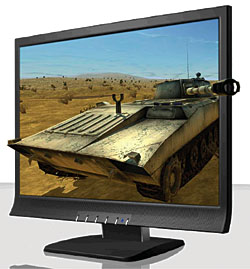 With Glasses, Will 3D
With Glasses, Will 3D
Several companies are working on displays for the home that still use glasses. Two in particular are of note, as they have nearly infinite content. Zalman and iZ3D are coming out with LCD monitors that are 2-D/3D switchable. The key is that all you need to make them fully 3D is a late-model NVIDIA graphics card and any video game that is rendered in 3D (as in, nearly all of them). Zalman will have a 19-inch, 1,280-by-1,024, 4:3 model, a 19-inch 16:9 model, and a 22-inch 16:9 model. iZ3D's model is 22 inches, 1,680 by 1,050, and 16:9.
The Zalman uses a Circular Polarization Optic Retarder. (I'm not kidding; that's the name.) The Retarder is in front of the LCD glass that creates the image. The Retarder's job is to polarize the image. It polarizes each frame for either the left or right eye, depending on what the graphics card tells the display. Simple and inexpensive polarized 3D glasses are required, of course. Zalman also plans to market larger displays with this technology in the future. The biggest downside is a very, very limited vertical viewing angle (10 degrees or so). So, don't bob your head with the action. The horizontal viewing angle is a little better, around 90 degrees.
The iZ3D, on the other hand, uses a second LCD panel in front of the one that creates the image. The additional LCD polarizes each pixel so that it goes to the correct 3D-glasses-covered eye.
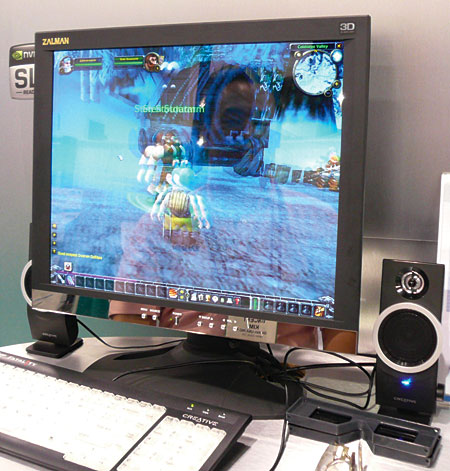
Reading about this technology, unfortunately, does it no justice. Seeing it in action on your favorite games, however, is possibly the greatest sales technique ever. At CES, I saw an early prototype of the Zalman model showing World of Warcraft. The background was deep into the monitor. Snow that the player kicked up came out of the monitor at me. It was so good, I was ready to pay money right there. It added that much more realism to the game. Unfortunately, as of this writing, neither display was ready for testing. As soon as they are, we'll review them.
iZ3D 22-Inch 3D Monitor
$999 (approximately)
www.iz3d.com
Zalman 19-Inch, 4:3 2-D/3D Monitor
$450 to $500
www.zalmanusa.com
